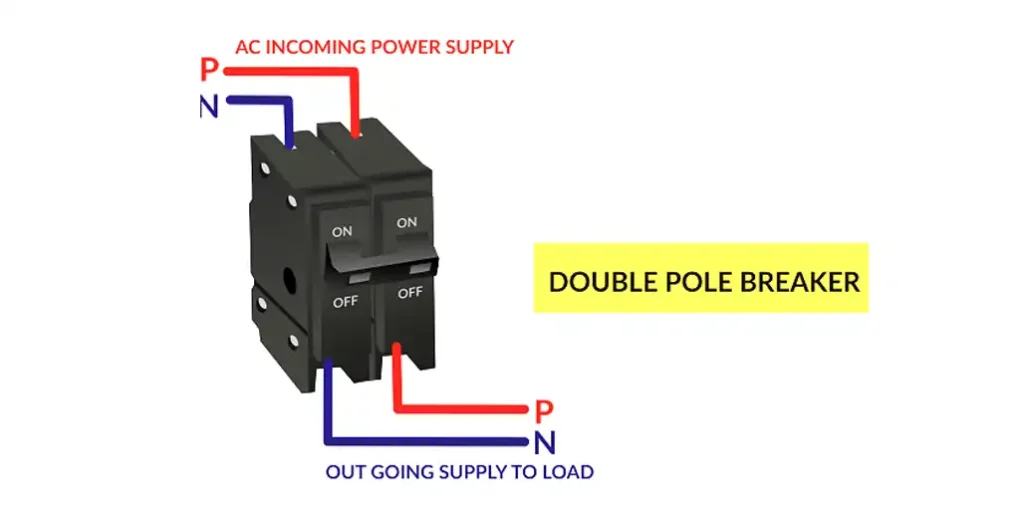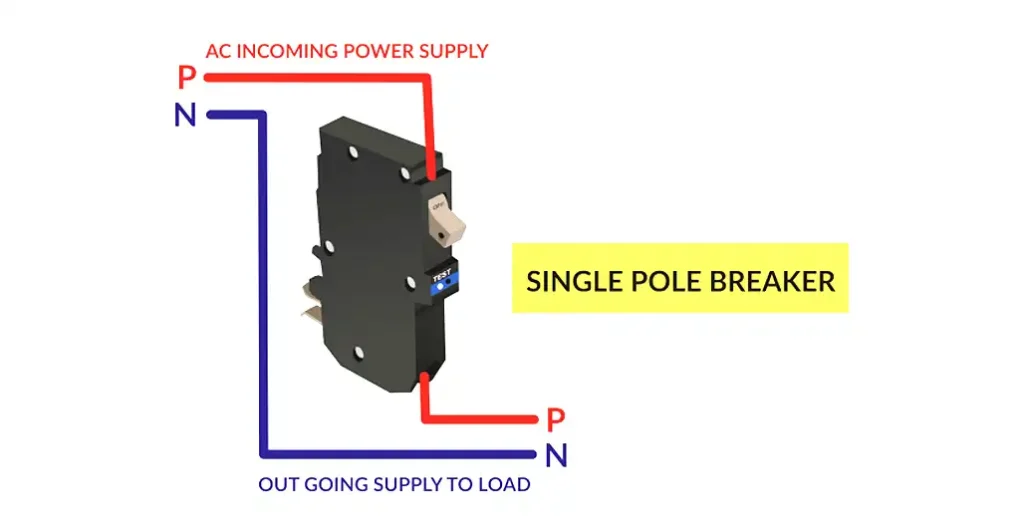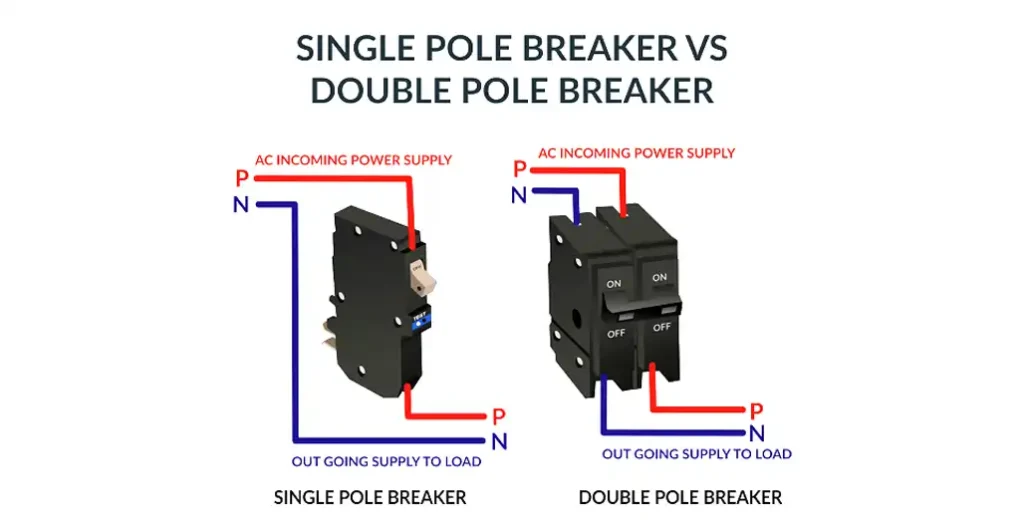Understanding the electrical systems in our homes and workplaces is vital to ensuring safety and efficiency. One essential component of these systems is the circuit breaker. Circuit breakers are designed to protect electrical circuits from damage caused by overload or short circuits.
This blog post will delve into the key differences between double pole and single pole circuit breakers, their applications, and the importance of their proper usage.
What Is Circuit Breaker
Circuit breakers are integral components of modern electrical systems, offering essential protection against electrical faults and ensuring the safety of property and individuals. This article explores the fundamental aspects of circuit breakers, their types, working principles, and their critical role in electrical systems.
Types of Circuit Breakers
Circuit breakers can be classified based on various parameters, including their voltage class, construction, and mechanism of interruption.
Based on Voltage Class
- Low Voltage Circuit Breakers (LV): Typically used in residential, commercial, and low-voltage industrial applications. They operate at voltages up to 1,000 volts.
- Medium Voltage Circuit Breakers (MV): Used in larger facilities, including industrial plants and commercial buildings. They operate between 1,000 volts to 72,500 volts.
- High Voltage Circuit Breakers (HV): Utilized in electric power distribution and transmission systems. They operate at voltages above 72,500 volts.
Based on Construction and Operation
- Miniature Circuit Breakers (MCB): Protect low current circuits where overload and short circuit conditions can occur. Ideal for residential applications.
- Molded Case Circuit Breakers (MCCB): Provide protection for a wide range of overload and short circuit conditions, typically used in larger industrial and commercial applications.
- Air Circuit Breakers (ACB): Operate in air as the arc extinguishing medium and are used for high current applications typically ranging from 800A to 10,000A.
- Vacuum Circuit Breakers (VCB): Use vacuum to extinguish the arc and are used for medium voltage applications up to 38 kV.
- Oil Circuit Breakers (OCB): Use oil as the arc extinguishing medium, typically used in high voltage applications.
- SF6 Circuit Breakers: Use sulfur hexafluoride gas to extinguish the arc, commonly used in high voltage applications.
What is Double Pole Circuit Breaker

A Double Pole Circuit Breaker (also named two pole circuit breaker, 2 pole circuit breaker) is a type of circuit breaker that is designed to interrupt both the live (hot) and neutral conductors of an electrical circuit simultaneously.
Here are the key points about double pole circuit breakers:
Purpose: The primary purpose of a double pole circuit breaker is to provide complete isolation of an electrical circuit by breaking both the live and neutral conductors when the breaker is tripped.
Application: Double pole circuit breakers are commonly used in single-phase electrical systems, such as residential and light commercial installations, where both the live and neutral conductors need to be disconnected for safety and to prevent the flow of current.
Functionality: When the double pole circuit breaker trips, it simultaneously interrupts both the live and neutral conductors, ensuring that no current can flow through the circuit, even if one of the conductors remains energized.
Advantages:
- Enhanced safety: By disconnecting both the live and neutral conductors, double pole circuit breakers provide a higher level of protection against electrical shocks and potential fire hazards.
- Improved circuit isolation: The complete isolation of the circuit helps to prevent the flow of current, even in the event of a fault or short circuit.
- Compliance with electrical codes: The use of double pole circuit breakers is often required by electrical codes and standards to ensure the safety of electrical installations.
Typical Ratings: Double pole circuit breakers are available in various current ratings, typically ranging from 15 Amps to 60 Amps, depending on the specific electrical load and application requirements.
Installation: Double pole circuit breakers are typically installed in electrical panels or distribution boards, where they provide protection for individual circuits or branch circuits.
What Is Single Pole Circuit Breaker

A Single Pole Circuit Breaker (also named one pole circuit breaker, 1 pole circuit breaker) is a type of circuit breaker that is designed to interrupt only the live (hot) conductor of an electrical circuit.
Here are the key points about single pole circuit breakers:
Purpose: The primary purpose of a single pole circuit breaker is to provide overcurrent protection for a single-phase electrical circuit by interrupting the flow of current through the live conductor.
Application: Single pole circuit breakers are commonly used in single-phase electrical systems, such as residential and light commercial installations, where only the live conductor needs to be disconnected.
Functionality: When the single pole circuit breaker trips, it interrupts the flow of current through the live conductor, effectively isolating the circuit from the power source. However, the neutral conductor remains connected, allowing any residual current to flow back to the power source.
Advantages:
- Simplicity: Single pole circuit breakers have a simpler design compared to double pole circuit breakers, making them generally more cost-effective.
- Versatility: Single pole circuit breakers can be used in a wide range of electrical installations, from residential to industrial settings, depending on the specific circuit requirements.
Limitations:
- Partial circuit isolation: Since the neutral conductor remains connected, single pole circuit breakers do not provide complete isolation of the electrical circuit, which can be a safety concern in certain situations.
- Potential for residual current flow: With the neutral conductor still connected, there is a possibility of residual current flow, which can pose a risk of electrical shock or fire.
Typical Ratings: Single pole circuit breakers are available in various current ratings, typically ranging from 15 Amps to 60 Amps, depending on the specific electrical load and application requirements.
Installation: Single pole circuit breakers are typically installed in electrical panels or distribution boards, where they provide protection for individual circuits or branch circuits.
Double Pole Circuit Breaker vs Single Pole

Here is a comparison of Double Pole Circuit Breakers and Single Pole Circuit Breakers, including a table highlighting the key differences:
Double Pole Circuit Breaker vs Single Pole Circuit Breaker:
Double Pole Circuit Breaker:
- Interrupts both the live (hot) and neutral conductors simultaneously.
- Provides complete isolation of the electrical circuit when tripped.
- Offers enhanced safety by disconnecting both conductors to prevent the flow of current.
- Commonly used in single-phase electrical systems, such as residential and light commercial installations.
- Ensures compliance with electrical codes and standards that require complete circuit isolation.
- Typically available in current ratings from 15 Amps to 60 Amps.
Single Pole Circuit Breaker:
- Interrupts only the live (hot) conductor, leaving the neutral conductor connected.
- Provides overcurrent protection but does not offer complete circuit isolation.
- Has a simpler design and is generally more cost-effective than double pole breakers.
- Can be used in a wide range of single-phase electrical installations, from residential to industrial.
- Poses a potential risk of residual current flow and electrical shock due to the connected neutral conductor.
- Typically available in current ratings from 15 Amps to 60 Amps.
Here is a table highlighting the key differences between single vs double pole circuit breaker:
| Feature | Double Pole Circuit Breaker | Single Pole Circuit Breaker |
|---|---|---|
| Conductors Interrupted | Live (hot) and Neutral | Live (hot) only |
| Circuit Isolation | Complete isolation of the circuit | Partial isolation, neutral remains connected |
| Safety | Enhanced safety by disconnecting both conductors | Potential risk of residual current flow |
| Compliance | Required by electrical codes for complete circuit isolation | May not meet all code requirements |
| Complexity | More complex design | Simpler and more cost-effective |
| Typical Applications | Single-phase residential and light commercial | Wide range of single-phase applications |
| Typical Ratings | 15 Amps to 60 Amps | 15 Amps to 60 Amps |
The key difference between double pole and single pole circuit breakers is the level of circuit isolation they provide. Double pole breakers offer complete isolation of the electrical circuit by interrupting both the live and neutral conductors, while single pole breakers only interrupt the live conductor, leaving the neutral connected. This difference in functionality has implications for safety, compliance, and the overall complexity of the circuit breaker design.
Circuit Breaker 2 Pole vs 1 Pole
Here is a detailed comparison of 2-pole (double pole) circuit breakers and 1-pole (single pole) circuit breakers:
2-Pole (Double Pole) Circuit Breakers:
- Interruption of Conductors: 2-pole circuit breakers interrupt both the live (hot) and neutral conductors simultaneously.
- Circuit Isolation: 2-pole breakers provide complete isolation of the electrical circuit when tripped, as both the live and neutral conductors are disconnected.
- Safety: The complete isolation of the circuit enhances safety by preventing the flow of current, even if one conductor remains energized.
- Applications: 2-pole breakers are commonly used in single-phase electrical systems, such as residential and light commercial installations, where complete circuit isolation is required.
- Compliance: The use of 2-pole circuit breakers is often mandated by electrical codes and standards to ensure the safety of electrical installations.
- Ratings: 2-pole circuit breakers are typically available in current ratings from 15 Amps to 60 Amps.
1-Pole (Single Pole) Circuit Breakers:
- Interruption of Conductors: 1-pole circuit breakers interrupt only the live (hot) conductor, leaving the neutral conductor connected.
- Circuit Isolation: 1-pole breakers provide overcurrent protection but do not offer complete isolation of the electrical circuit, as the neutral conductor remains connected.
- Safety: The connected neutral conductor poses a potential risk of residual current flow and electrical shock.
- Applications: 1-pole breakers can be used in a wide range of single-phase electrical installations, from residential to industrial.
- Compliance: 1-pole breakers may not meet all code requirements for complete circuit isolation, depending on the application.
- Ratings: 1-pole circuit breakers are typically available in current ratings from 15 Amps to 60 Amps.
Comparison Table:
| Feature | 2-Pole (Double Pole) Circuit Breaker | 1-Pole (Single Pole) Circuit Breaker |
|---|---|---|
| Conductors Interrupted | Live (hot) and Neutral | Live (hot) only |
| Circuit Isolation | Complete isolation of the circuit | Partial isolation, neutral remains connected |
| Safety | Enhanced safety by disconnecting both conductors | Potential risk of residual current flow |
| Compliance | Required by electrical codes for complete circuit isolation | May not meet all code requirements |
| Complexity | More complex design | Simpler and more cost-effective |
| Typical Applications | Single-phase residential and light commercial | Wide range of single-phase applications |
| Typical Ratings | 15 Amps to 60 Amps | 15 Amps to 60 Amps |
The key difference between 2-pole and 1-pole circuit breakers is the level of circuit isolation they provide. 2-pole breakers offer complete isolation of the electrical circuit by interrupting both the live and neutral conductors, while 1-pole breakers only interrupt the live conductor, leaving the neutral connected. This difference in functionality has implications for safety, compliance, and the overall complexity of the circuit breaker design.
Conclusion
In summary, the key distinction between double pole and single pole circuit breakers lies in their ability to isolate electrical circuits. Double pole circuit breakers interrupt both the live and neutral conductors, providing complete circuit isolation when tripped. This enhanced safety feature is essential in many residential and commercial applications, as it prevents the flow of current even if one conductor remains energized. In contrast, single pole breakers interrupt only the live conductor, leaving the neutral connected and posing a potential risk of residual current flow.
If you need high-quality double pole or single pole circuit breakers, get a quote from our reputable circuit breaker manufacturer. Our team of experts is dedicated to providing reliable and code-compliant solutions to meet your needs.




















